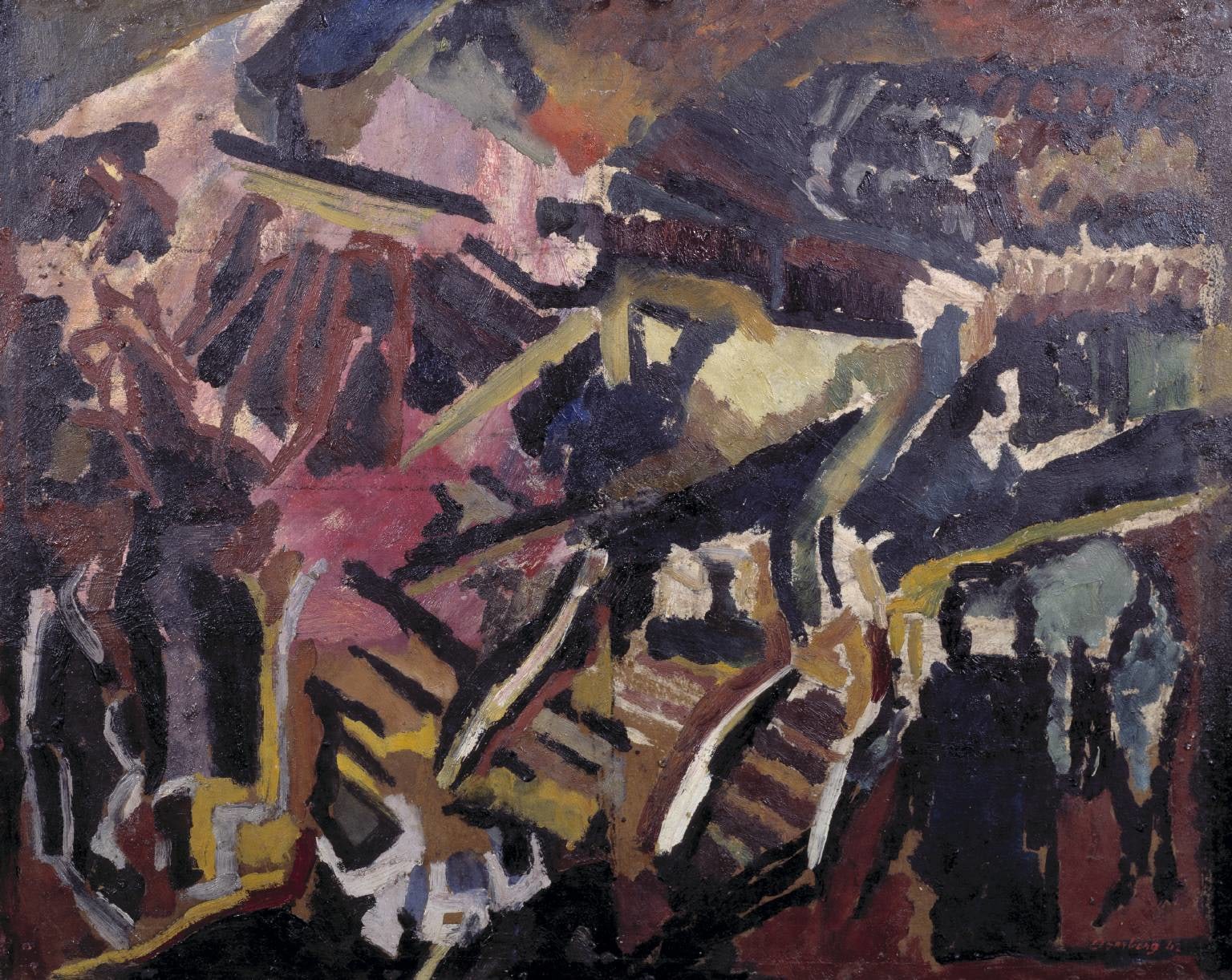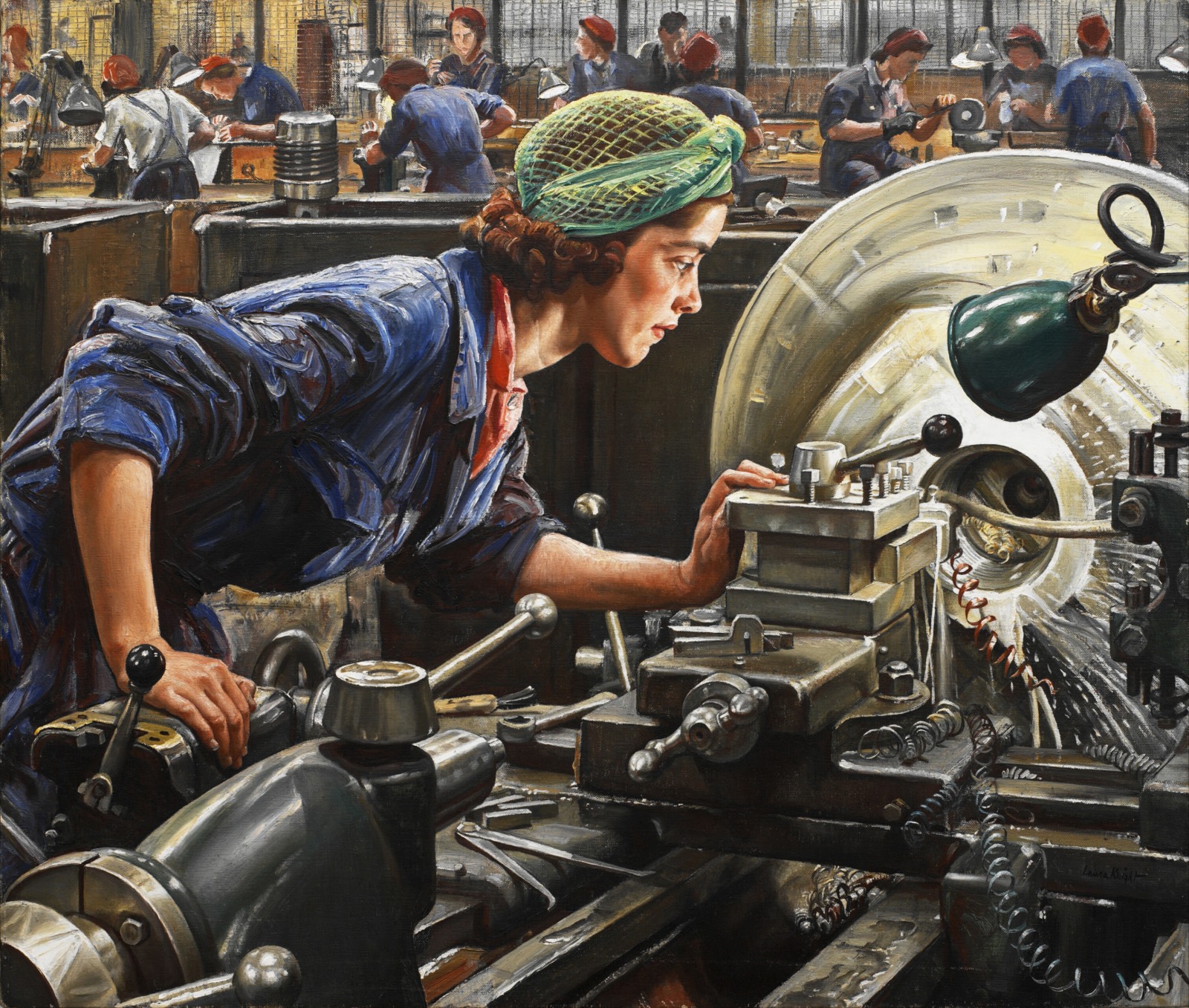Having been an official war artist in the First World War, David Bomberg felt himself well equipped to serve when another general war broke out in 1939. His efforts proved to be far in advance of contemporary tastes.
InSight No. 146
David Bomberg, Bomb Store, 1942
Owing to the greater threat and prevalence of aerial bombing, the Second World War—much more so than the First—was marked by subterranean escapades. Tube stations became air raid shelters and garden lawns were dug over for Anderson shelters. Basements and wine cellars took on new significance. A disused slate mine in Snowdonia was used to store much of the National Gallery’s collection. Another precious asset—munitions—was also preserved in underground storage facilities across the country. The largest was the Central Ammunition Depot at Monkton Farleigh, Somerset, near Corsham, created from a disused mine where Bath Stone was once extracted. Similar deposits existed at Llanberis in Wales, Linley Caverns in Staffordshire and Harpur Hill in Derbyshire. The RAF deposit at Fauld, Staffordshire, was depicted in a series of works by David Bomberg (1890–1957) in 1942, just two years before a massive explosion decimated the site and caused an estimated 70 deaths.

Correspondence between Bomberg and the War Artists’ Advisory Committee, now preserved in the archives of the Imperial War Museum, shows the reticence of officials to contract his involvement as an official war artist. Although he wrote offering his services as early as December 1939, it was not until February 1942 that he was awarded the commission to paint an underground bomb store for a fee of 25 guineas. He responded with fervour and produced a large cycle of work that included many oil paintings on paper and a small number of charcoal drawings, these made in situ, and a handful of paintings on canvas, mostly worked up on his return to London. The Bomberg specialist Richard Cork has written that these works ‘deserve to be counted among [the artist’s] finest achievements’.

The bomb store allocated to Bomberg was a converted gypsum mine. Some of his charcoal drawings evoke cavernous spaces, their high vaults lost in shadow. Recurrent motifs in his bomb store pictures include railway tracks, sometimes discernible in the foreground, and parallel lines of short cylindrical canisters, stacked in orderly mounds sometimes as many as nine high—the bombs. The armature of props and supports in the mine was integral to most of Bomberg’s pictures. These diagonal, vertical and horizontal beams interlock in a contorted web of jagged patterning. Some of these lines are steeply foreshortened while others lock together as inverted V shapes, some of which frame unexpectedly deep vistas running deeper into the tunnels.

Whether made in situ or later finished in the studio, the bomb store works create an acute tension between pictorial information and terse, inventive formalisation. The application of paint in literal, rough-textured brush strokes is urgent and uncontrived. Although the colouring is grim and soot black throughout, largely owing to the prevailing darkness in the bomb store itself, sharp contrasts of lilac, yellow and pale grey shimmer in the darkness with strange lucidity. Oblivious to the WAAC’s prevailing appetite for illustrational clarity, which was readily satisfied by the likes of Stanley Spencer and Laura Knight, Bomberg responded to his allotted subject with characteristic conviction and single-mindedness.

When Bomberg presented the WAAC with a group of seven works, the committee returned all but three drawings. It further refused the artist’s suggestion of producing a large-scale ‘Memorial Panel’ in honour of those who worked in munition stores. In contrast to this unfavourable reception, since the nineteen-eighties many of Bomberg’s bomb store pictures have been acquired for UK public collections. In 1989, the Imperial War Museum itself purchased a charcoal drawing (illustrated above)—the obvious extensions of which set a precedent for the patching technique used by Bomberg’s tutee Frank Auerbach. In 1993 and 1995, the Tate Gallery acquired oils on paper and board respectively. Growing appreciation of the bomb store pictures is also apparent from a comparison of two retrospectives of Bomberg’s work: whereas the 1967 Arts Council exhibition included just two bomb store pictures, Richard Cork’s 1988 Tate Gallery exhibition included eleven. Where he was once valued chiefly for his youthful achievements as a Vorticist, Bomberg today continues to be discovered as an artist of surprising range and tenacity—qualities which are strongly attested to by his bomb store cycle.
Images :
1. Bombs being stacked in a tunnel at RAF Fauld, n.d., photographed by B.J. Daventry, Imperial War Museums
2. David Bomberg, Bomb Store, 1942, Tate © The Estate of David Bomberg
3. Laura Knight, Ruby Loftus screwing a Breech-ring, 1943, Imperial War Museums © The Estate of Dame Laura Knight
4. David Bomberg, Bomb Store, 1942, Imperial War Museums © The Estate of David Bomber


